This small, hard paste ceramic ovoid shaped teapot with colorful hand painted floral decoration in oval reserves on a blue ground has sustained more damage than just about any other piece in my collection. Most likely made in Moscow in the early 1900s for the Persian market, it came from the estate of a doctor who taught medicine in Afghanistan in the 1950s-60s and travelled extensively, acquiring items from around the world. The multiple repairs appear to have been done in Persia over a period of time, and include a number of staples, a replaced metal spout, a large patch made from a tin can cemented to one side, a green string tethering the mismatched lid to the handle, and an inexplicable metal buttress encompassing the body. Teapot measures 4″ high by 8-1/2″ wide from handle to spout and is marked on the base with cursive letters JTC in a decorative cartouche.
This teapot with similar form and decoration was made by the Gardner Porcelain Factory in Moscow, c.1860.
Photo courtesy of the Victoria & Albert Museum
Tags: Eastern European, metal spout, metal strap, pottery
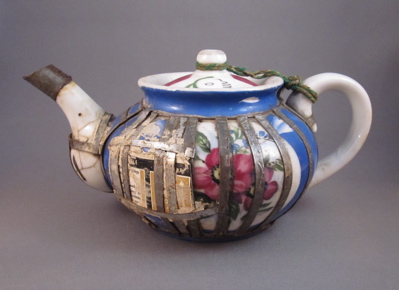
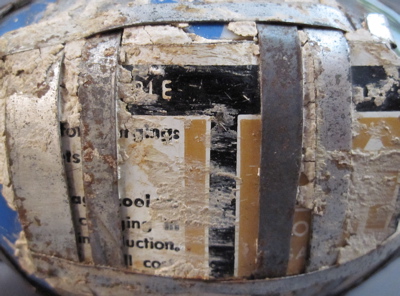
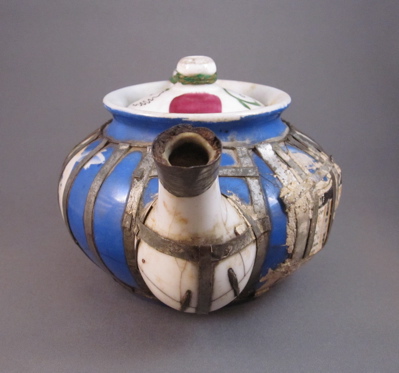


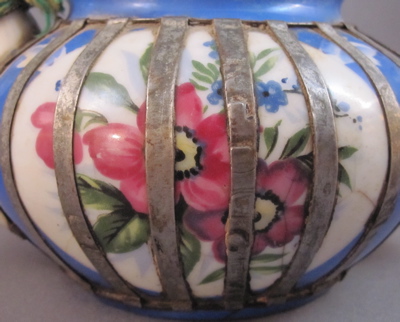
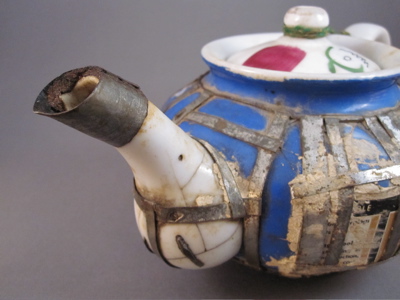
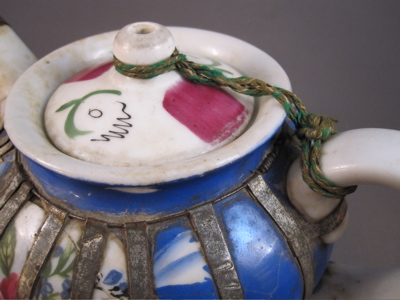
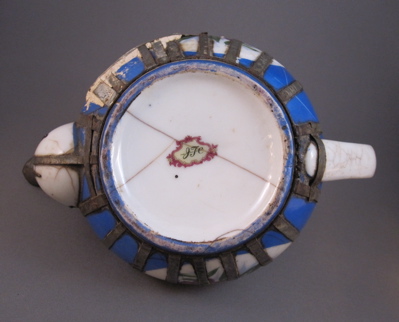

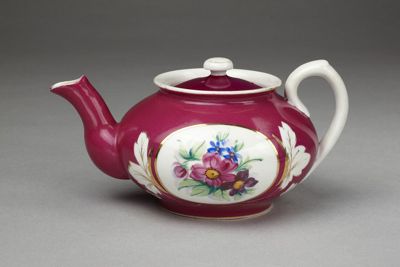
This looks fabulous! What an assemblage of repairs. Happy find for your collection. Thank you for sharing.
Wow, this little teapot has certainly been to hospital or is it the dentist. A very treasured item to withstand this amount of inventive repair. The most bizarre make do that I have yet seen. Well done Andfrew, you cease to amaze us!
My god, that begs the question, why bother?
It must have had either some strong family connection or was owned by someone who was not going to give up on this object and had the skill or the money to repair it. Great history!
The tin can patch takes the cake!
Love your site!
DR
I just found your collection and I am so grateful to see so many fantastic examples of metal repairs. I am a ceramics conservator and will be presenting a paper on the history and consrevation of these repairs at a conservation conference later this year. I have started my own small collection, but being in Australia I don’t quite have the access to quite so many fabulous pieces! I look forwards to spending some more time having a more detailed look at all your objects. Thanks!
Very suggestive object…the metal straps over the original floral decoration calls to mind a private garden protected by an iron fence. All old repairs carry a poignancy, this one perhaps more than most!
@Kasi Albert
I happen to live in Sydney and have a small but good collection of cGardener teapots and cups all brillantly repaired.
I travelled in Afghanistan in the 60s and found the
m irresistible.
I also found other ones as far as Kashgar in Chinese Turkestan
and Samarkand.
I’d be delighted tu send you some picts if you carr.
Remy G.-L.
Stunning. Beautiful. Thank you for sharing. Has me question my thoughts that all broken pots are requests to go back to Mama and to get chucked into the pit.
I love this article. The best part is where you point out that the repaired glass goblet is more beautiful than one in original condition. Bravo! Charles Eames once said that he yearned to have “well darned socks.” Both he and Ray would have holes in their clothes patched or darned or re-woven, rather than throwing them away. Some of my favorite mid-century designs are ones that show honest signs of wear, or even, in some cases, interesting repairs.
These are fascinating homely objects…in the case of this repaired piece, I have to wonder: was it primarily sentiment that made people so protective of these shattered objects? It seems with some of them that they are not nearly as serviceable as before, so I am thinking mere frugality doesn’t quite explain it. Any insight on this?